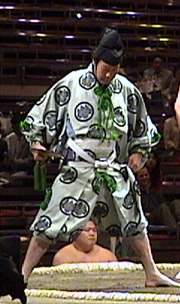
![]()
What Will Become of the Dynasty?
Brian Lewin
The Hanada Dynasty – past or present?
Rikishi of Old
Joe Kuroda
A look at a rikishi of yesteryear with Tenryu our man for August.
Heya Peek
John Gunning
John attends a chanko session at Chiganoura Beya.
Photo Bonanza
For a glimpse at some of the sights you won't see on TV.
July Basho Review
Lon Howard & John Gunning
Lon gives us his Nagoya Basho summary and his take on upset of the tournament while John chips in with his ‘gem’ of the basho.
Lower Division Rikishi
Mikko Mattila takes a break and Eric Blair covers the lower divisions in his own ‘unique’ way.
Aki Basho Forecast
Pierre Wohlleben & Mark Buckton
Pierre predicts the Aki Basho banzuke while Mark previews the ones to watch next time out.
Sumo 101
Barbara Ann Klein
Gyoji goings on and several things you never knew about the ones officiating.
Kimarite Focus
Mikko Mattila
Mikko walks us through his 2 chosen kimarite.
Minusha
John McTague
John's unique view of news from outside the dohyo.
Boletín de Sumo en Español
Eduardo de Paz Gútiez
An article on sumo’s very first fan mag – Boletin de Sumo en Espanol
Online Gaming
Jezz Sterling
Hear from the founder of Bench Sumo of one of sumo's most popular games.
Kokugi Connections
Todd Lambert
Todd’s focus on 3 of the most interesting online sumo sites today.
Fan Debate
Henka – good, bad or ugly? See what our debaters think.
Let’s Hear From You
What was it that made you a sumo fan – the Petros Zachos story.
Ngozi on the Road
Ngozi T. Robinson
NTR visits an amasumo event in the north-east U.S. and tells us what it was like.
Sumo Quiz
The Quizmaster
Answer the Qs and win yourself next basho's banzuke.
Sumo 101:
The Gyoji
Barbara Ann Klein

Refereeing, however, is not the only duty of the gyoji. They “write” the banzuke and the daily torikumi in the distinctive sumo-style writing.
Next Home
This month, we are focusing on those (mostly) little men on the dohyo, who, in stark contrast to the near-naked men about to fight, are dressed in ornate cottons and silks, sporting a peculiar black hat, and carrying a brightly tasseled wooden paddle (gunbai).
These are the gyoji – the referees who officiate each bout of each day of the tournament. In fact every sumo bout is called by a gyoji – whether in the grand tournaments, the local tours, the overseas exhibitions, or, even comedy sumo!
Let’s examine this unique position and its traditions.
The gyoji's main and most visible duty is to adjudicate the bouts between the rikishi. After the yobidashi, or caller, announces the names and sides, i.e., east or west, of the two men facing each other in the next bout, the gyoji repeats the names, effectively calling the rikishi onto the dohyo. He begins his responsibility by taking a traditional stance facing east, with his gunbai also held to the east, while watching over the rikishi as they go through their respective pre-tachiai rituals. When he is given the signal by the shinpan designated as the time keeper, the gyoji faces shomen (front), standing between the two rikishi, and raises his gunbai flat-side forward. This is to let the rikishi, as well as the spectators, know that it is time to start the bout. He will
![]()
announce “jikan desu”, “katta nashi”, “matta nashi” or other phrases (it’s time, time is up, no false starts) which signal the official start of the bout. He must assure that the initial contact between the rikishi is strictly coordinated. However, if the gyoji feels that the charge has not been appropriately synchronized, or if there has been a false start, he will say “matta” (wait), and require the rikishi to begin again.
Once contact has been made, and the rikishi are engaged in the struggle, the gyoji encourages the rikishi with a series of shouts – “hakkeyoi” at the initial engagement, and repeated if they come to a halt, or “nokotta, nokotta”, still in, when both rikishi are in motion. When one of the combatants is determined as the winner, the
![]()